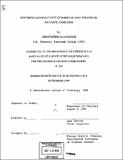Synthesis and reactivity of rhenium and technetium polyaryl complexes
Author(s)
Morse, Christopher Alan
DownloadFull printable version (7.641Mb)
Advisor
Alan Davison.
Terms of use
Metadata
Show full item recordAbstract
Chapter 1. The organometallic chemistry of rhenium includes a variety of [sigma]-aryl complexes. The syntheses and structures for these complexes follow a pattern that relates predominantly to their oxidation states. The high oxidation state compounds all contain oxo or imido ligands. The low oxidation state complexes are mostly carbonyl and phosphine complexes, many of which result from orthometallation of a ligand. The middle oxidation state compounds bridge the motifs seen in the higher and lower oxidation states. A summary of rhenium-carbon bond lengths is presented. Chapter 2. Several complexes of the form Re(aryl)3(PMe2Ph)2 have been synthesized from ReCl 3 (PMe 2 Ph) 3, where aryl is m-tolyl, p-tolyl, phenyl, or p-methoxyphenyl. The complex Re(p-tolyl)3(THT)2 (THT = tetrahydrothiophene) was synthesized from ReBr3(THT) 3 and was structurally characterized by a single crystal X-ray diffraction study. It was found to have a nearly ideal trigonal bipyramidal structure with a propeller arrangment of aryl rings in the trigonal plane. The average Re-C bond length in Re(p-tolyl)3(THT)2 was 2.04 Å. Treating in situ solutions of Re(p-tolyl)3(THT)2 with phosphines results in complexes of the form Re(ptolyl) 3(PR3)2, where PR3 is PMe2Ph, PPh3 or PMe3. Several polyaryl rhenium complexes with chelating phosphines are synthesized and examined. Chapter 3. The complex Re(p-tolyl)3(PMe2Ph) 2 is used as a probe to study the stability and reactivity of rhenium tris(aryl) complexes. The complexes are stable to temperature and substitution, but decompose in the presence of many oxidants by forming biphenyl as a reductive elimination product and unknown rhenium complexes without coordinated aryl groups. In the presence of carbon monoxide, Re(p-tolyl)3(PMe2Ph)2 reductively eliminates biphenyl and forms the rhenium(I) complex mer- Re(CO)3(PMe2Ph)2(p-tolyl). An X-ray structural analysis of mer- Re(CO)3(PMe2Ph)2(p-tolyl) shows a nearly ideal octahedral geometry with a long Re-C aryl bond length of 2.19 A. The complex Re(CO) 3 (PMe2Ph) 2 (ptolyl) can be treated with iodine to form Re(CO) 3 (PMe 2Ph) 21. Chapter 4. Technetium has a limited number of known organometallic compounds. Most of these complexes have carbonyl or isonitrile ligands. A small number of technetium complexes have anionic or polyhapto organometallic ligands. These include a variety of cyclopentadienyl complexes and r 6 -arene complexes. Recently, the organometallic complexes of technetium have come to include ll-sigma donors as well as multiply bonded alkylidenes and alkylidynes. A summary of technetiumcarbon bond lengths is presented. Chapter 5. The first technetium aryl complexes were synthesized from TcC13(PMe2Ph)3. They have the general formula Tc(aryl)3(PMe2Ph)2, where aryl is p-tolyl, m-tolyl, or phenyl. The complex Tc(ptolyl) 3(PMe2Ph)2 was structurally characterized by a single crystal X-ray diffraction study which found the technetium in a trigonal bipyramidal arrangment with a Tc-C average bond length of 2.037 A. Both the m-tolyl and p-tolyl analogs of Tc(aryl)3(PMe2Ph)2 react with carbon monoxide to reductively eliminate biphenyl and benzophenone resulting in technetium(I) complexes of the form Tc(CO)3(PMe2Ph)2(aryl). An X-ray structural analysis of Tc(CO) 3(PMe 2Ph)2(m-tolyl) showed an octahedral coordination around the metal with a long Tc-C bond length of 2.242 A. The complex Tc(p-tolyl)3(PMe2Ph) 2 also reacts with tBuNC to form a technetium(I) organometallic oil formulated as Tc(tBuNC) 3 (PMe 2Ph) 2(ptolyl). The complex TcC14(THT) 2 (THT = tetrahydrothiophene) was synthesized from TcC16 2- and was structurally characterized by an X-ray crystallographic analysis. The structure for TcC14 (THT) 2 showed a standard octahedral coordination around the technetium(IV) center.
Description
Thesis (Ph.D.)--Massachusetts Institute of Technology, Dept. of Chemistry, 1998. Vita. Includes bibliographical references (leaves 162-163).
Date issued
1998Department
Massachusetts Institute of Technology. Department of ChemistryPublisher
Massachusetts Institute of Technology
Keywords
Chemistry